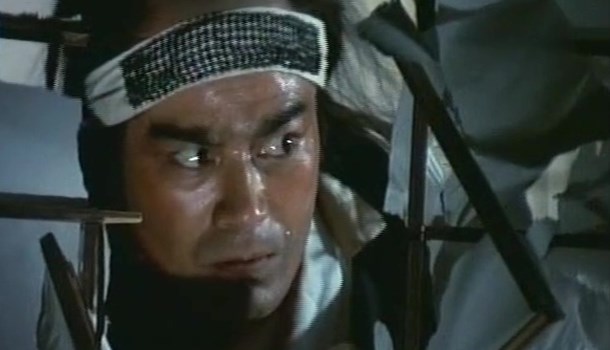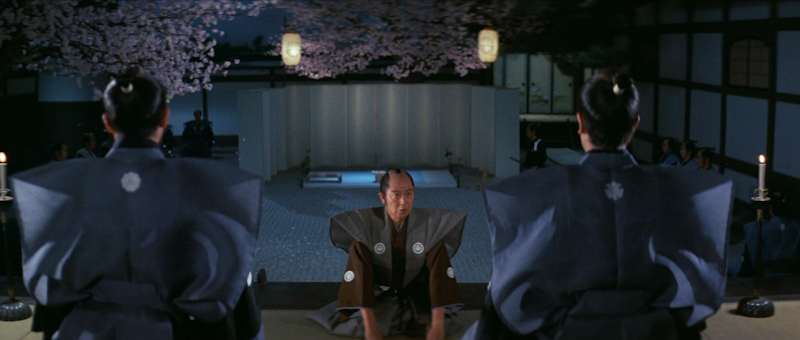
Written by Richard Durrance on 08 Jan 2024
Distributor Eureka • Certificate 15 • Price £17.99
Again, we delve into Eureka’s exploration of Kinji Fukasaku’s work outside the yakuza genre, with another telling of the 47 Ronin: The Fall of Ako Castle (1978). Eureka’s previous release of Fukasaku’s Samurai Reincarnation was excellent and so I had high hopes for The Fall of Ako Castle but also one reservation following my attempt to watch the version of the story by Kon Ichikawa from the 80’s on a bad DVD. I gave up on this version in part due to the terrible print but also due to the problem inherent in many stories where the characters are varied and many: the need to over explain who everyone is, to contextualise to the point where the viewer who is not conversant with the history is left reeling, overloaded and baffled. Lightness in such storytelling is a difficult art. Could Fukasaku be the man to make the story work for the layman?
In passing, but with malice, Lord Kira insults Lord Asano, resulting in an attack by Asano driven by anger, wherein Kira doesn't so much drawing his sword. At the Shogun’s insistence the investigation into the attack is cut short, the blame heaped individually upon Asano, despite the samurai code requiring punishment to both parties, with the resultant removal of the Asano clan’s land and Asano ordered to commit seppuku.
News spreads to the Asano clan's Ako Castle, where the senior samurai retainers must decide how to act so that their honour is intact while avoiding retaliation upon their families. The young samurai want revenge on Kira, but senior samurai Oishi (Yorozuya Kinnosuke) has a different plan, one that provides revenge not just against Kira but the government that acted so unjustly.
Not so much a story of revenge then, but one of righteousness, justice and abiding by the code of the samurai. There is significant effort in defining the nature of the injustice at the heart of the tale in the storytelling, because of the importance of this to Oishi and those that follow him. Here, revenge is not some mad act of violence but a carefully considered, constructed action that must be seen to be done in the proper way, so those who will witness or hear of the event will recognise how it shames the shogun and his government. This understanding is key to why the story is so resonant in Japanese culture.
The opening setup is suitably tight (and bear in mind this is a two-hour forty-minute film so there is a lot to pack in), but the pacing throughout is excellent. The eventual act of revenge is relatively short so much of the story focusses on the characters, especially Oishi and those samurai that follow him as they wait for month after month to take their vengeance. Here, samurai show their relative lack of temperament, acting rashly, sometimes not, sometimes even losing faith in Oishi, but what really works in the build-up is how we see what the fallout of the decision to take the Asano clan apart is.
This is multifaceted, so that we witness not only how it effects the Asano clan but those that have to protect Kira - it’s generally assumed Oishi will seek revenge but the how and when is what makes the tension. Similarly the court itself reflects the intrigue surrounding the assumed retaliation, as does the stress of Oishi’s samurai and their families. For Oishi and his clan, the waiting and need to avoid retribution against their families tears them apart.
As such you might expect The Fall of Ako Castle to be more of a chanbara (sword fighting), though it’s fair to say it aligns more closely in jidaigeki (period drama), in my opinion. There’s relatively little action, something that may come as some surprise considering Sonny Chiba is second billed. Then again Toshiro Mifune is final billed in that “and” role that denotes importance, and both actually have relatively small roles. Really much of the film falls onto the shoulders of Oishi and a handful of immediate, often young, samurai. So, I felt the film became as much a character study, about how experience tempers or destroys a person – how faith can be unwavering or uncertain; how doubt that corrupt your intent based on a selfish need to act, and not to consider more wisely the importance of that action. Much of the drama then comes from how Oishi’s actions, his communication, or lack of, is interpreted by what are described as being mainly inexperienced samurai who are more samurai in name than in actuality.
Fukasaku’s experience of telling complex interweaving stories with more characters than you could hope to count from his Battles Without Honour and Humanity series holds him in good stead, because though the story moves between Oishi’s samurai and the court, he never gets bogged down in excessive detail. The story moves fluidly enough so that even if we don’t always quite catch who everyone is, it doesn't matter because Fukasaku always gives us the essence of what each scene or sequence needs to be rather than get too lost in minutiae.
This narrative lightness means that the film’s length never feels long, rather that we are witnessing just the right level of information to understand both why the Asano samurai are doing what they are but also the importance of it and why it should be such a key historical incident. Exactly who many of the lords are is arguably immaterial in a film of this length (a TV mini-series might be different because of having more time to explore the milieu), instead the film concentrates on nailing the broad aspects of why and how matters here and the balance was right for me. Stylistically this is worlds apart from many of his earlier films, it's far more formalised visually, though the battles themselves share some of the more kinetic, frantic nature of the fights in say the Battles films. This visual change is something that works for the film, because to have shot it like many of his earlier yakuza films would have been jarring, an accusation I might still throw at the soundtrack which is more reminiscent of Shaft, if Shaft had been a samurai movie.

As you can imagine then, The Fall of Ako Castle has no small cast, and there are more familiar faces than you can count, but much of the story really does fall on Yorozuya Kinnosuke as Oishi. It’s a role that needs to be both intense and humorous. Oishi, while planning the revenge, was happy to seen to have forsaken vengeance, becoming a painter in the floating world, even by his own samurai and is criticised for this by many in the film. Kinnosuke embodies the driven samurai who is a model for those following him, even if they don’t know it, because he is not driven by selfish impulses and able to steel his soul with patience. I did appreciate the casting of Nobuo Kaneko as Lord Kira, considering Kaneko played the conniving, snivelling yakuza boss in the Battles films and Kira is a similar sly, cowardly and manipulative character, so he seemed a shoo-in for the role.
The Fall of Ako Castle, as a telling of a complicated story that could have been prone to be overdetailed, is instead a surprisingly accessible and spry piece of storytelling, focussing on how one act of provoked violence and single-sided justice can spiral so that it becomes an historically important moment. Following character over action is never dull and provides a more meaningful experience, while the director keeps the film visually engaging. It’s no small feat to make the drama between action scenes as compelling as the more obviously cinematic moments, but then this should be no surprise as most of Fuksaku’s work I’ve seen is essentially drama peppered with action. His ability to focus on character and dramatic tension has always been there but maybe a little hidden because it’s easy to look at the more stylised moments in his films, or the more violent ones, than to recognise how well he handles the glue that is cinematic drama - you always notice when this is done badly, but done well it remains largely unnoticed. This is why we should celebrate another release that shows Fukasaku's work in other genres, which are less easily accessible.
Eureka, more please.

Long-time anime dilettante and general lover of cinema. Obsessive re-watcher of 'stuff'. Has issues with dubs. Will go off on tangents about other things that no one else cares about but is sadly passionate about. (Also, parentheses come as standard.) Looks curiously like Jo Shishido, hamster cheeks and all.
posted by Richard Durrance on 12 Dec 2025
posted by Ross Locksley on 09 Dec 2025
posted by Richard Durrance on 28 Nov 2025
posted by Richard Durrance on 25 Nov 2025
posted by Richard Durrance on 18 Nov 2025
posted by Richard Durrance on 14 Nov 2025
posted by Richard Durrance on 11 Nov 2025
posted by Richard Durrance on 07 Nov 2025